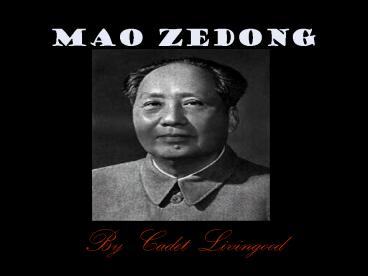mao zedong PowerPoint PPT Presentation
1 / 10
Title: mao zedong
1
mao zedong
- By Cadet Livingood
2
Mao Zedong or Mao Tse-tung , 18931976, founder
of the People's Republic of China
3
Of peasant stock, Mao was trained in Chinese
classics and later received a modern education.
As a young man he observed oppressive social
conditions, becoming one of the original members
of the Chinese Communist party.
Mao's ideas on revolutionary struggle and
guerrilla warfare were extremely influential.
4
With eldest son Anying at the Fragrant Hills 1949
He organized peasant and industrial unions and
directed (1926) the Kuomintang's Peasant Movement
Training Institute. After the
Kuomintang-Communist split (1927), Mao led the
disastrous Autumn Harvest Uprising in Hunan,
leading to his ouster from the central committee
of the party.
5
The Long March was a massive military retreat
undertaken by the Chinese Communist Army to evade
the pursuit of the Nationalist Chinese army. The
Communist Army of the Chinese Soviet Republic,
led by Mao Zedong and Zhou Enlai, was on the
brink of complete annihilation by Chiang
Kai-Shek's troops in Jiangxi Province in October
1934. The communists escaped in circling
retreat to the north, which ultimately covered
some 4960 miles over 370 days. The route branched
through some of the most difficult terrain of
western China and arrived 5952 miles west, then
north, to Shaanxi
6
(No Transcript)
7
(No Transcript)
8
After the Japanese were defeated in World War II,
the Communists defeated the Kuomintang in an
ensuing civil war and established the People's
Republic of China on October 1, 1949. It was the
culmination of over two decades of Communist
Partyled popular struggle. From 1954 to 1959,
Mao was the Chairman of the PRC. He took up
residence in Zhongnanhai, a compound next to the
Forbidden City in Beijing, and there he decreed
the construction of an indoor swimming pool and
other buildings. Mao often did his work either in
bed or by the side of the pool during his
chairmanship, according to Dr. Li Zhisui, who
claimed to be his physician. (Li's book has been
subject to controversy.)
A campaign to reestablish Mao's ideological line
started in the Cultural Revolution. Mass
mobilization was directed against the party
leadership. In 1969 Mao reasserted his party
leadership by serving as chairman of the Ninth
Communist Party Congress, and in 1970 he was
named supreme commander of the nation and army.
After the Japanese were defeated in World War II,
the Communists defeated the Kuomintang in an
ensuing civil war and established the People's
Republic of China on October 1, 1949. It was the
culmination of over two decades of Communist
Partyled popular struggle. From 1954 to 1959,
Mao was the Chairman of the PRC. He took up
residence in Zhongnanhai, a compound next to the
Forbidden City in Beijing, and there he decreed
the construction of an indoor swimming pool and
other buildings. Mao often did his work either in
bed or by the side of the pool during his
chairmanship, according to Dr. Li Zhisui, who
claimed to be his physician. (Li's book, The
Private Life of Chairman Mao, has been subject to
controversy.)
9
- The cultural revolution group continued its
campaigns until Mao's death in Sept., 1976. - A month later its leaders were purged and Mao's
surviving opponents slowly regained power pushing
aside Mao's successor, Hua Guofeng, and erasing
the cult surrounding Mao.
10
The End

